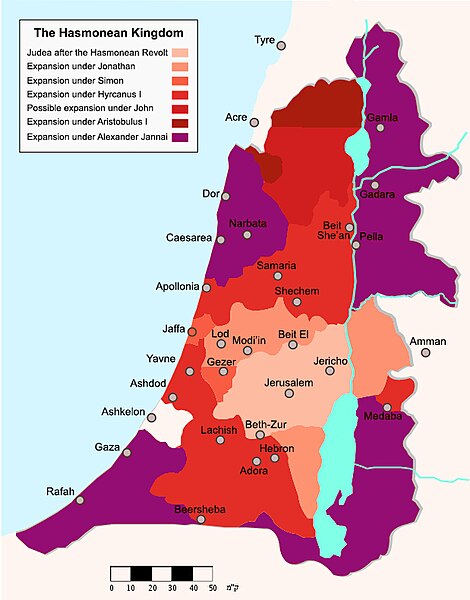John Hyrcanus was a Hasmonean (Maccabean) leader and Jewish high priest of the 2nd century BCE. In rabbinic literature he is often referred to as Yoḥanan Cohen Gadol, "John the High Priest".
Judea, Hasmoneans. John Hyrcanus I (Yehohanan). 135–104 BCE. Æ Prutah (13mm, 2.02 gm, 12h). "Yehohanan the High Priest and the Council of the Jews" (in Hebrew) in five lines within wreath / Double cornucopia adorned with ribbons; pomegranate between horns; small A to lower left. Meshorer Group B, 11; Hendin 457.
The Hasmonean dynasty was a ruling dynasty of Judea and surrounding regions during the Hellenistic times of the Second Temple period, from c. 140 BCE to 37 BCE. Between c. 140 and c. 116 BCE the dynasty ruled Judea semi-autonomously in the Seleucid Empire, and from roughly 110 BCE, with the empire disintegrating, Judea gained further autonomy and expanded into the neighboring regions of Perea, Samaria, Idumea, Galilee, and Iturea. The Hasmonean rulers took the Greek title basileus ("king") as the kingdom became a regional power for several decades. Forces of the Roman Republic intervened in the Hasmonean Civil War in 63 BCE and made it into a client state, marking the decline of Hasmonean dynasty; Herod the Great displaced the last reigning Hasmonean client-ruler in 37 BCE.
Hasmonean dynasty
Wojciech Stattler's Machabeusze (Maccabees), 1844
Coin with portrait of Antiochus IV. Reverse shows Apollo seated on an omphalos. The Greek inscription reads ΒΑΣΙΛΕΩΣ ΑΝΤΙΟΧΟΥ ΘΕΟΥ ΕΠΙΦΑΝΟΥΣ ΝΙΚΗΦΟΡΟΥ (King Antiochus, the divine Epiphanus, Bringer of Victory.
Mattathias of Modi'in killing a Jewish apostate, engraving by Gustave Doré





